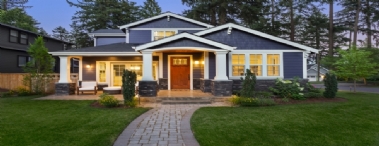
Landscaping alters the shape of your property, enhances your enjoyment of the space and improves value. But a good landscape design takes time. Learn how to create that landscape plan from scratch and build the outdoor living space you've been dreaming about.
Dream and Assess
Start by looking at your entire landscaping project and ask the following questions:
- What do you want from your yard?
- Will this be a place for your family to hang out and play, or do you strictly want to improve the view from inside?
- Are you interested in controlling your heating and cooling costs with trees or would you rather allow natural light to filter in?
- How much maintenance can you afford to handle? Will you like perennial plants or seasonal flowers, which you have to replace after a few months?
- Do you have the time and skills to do it yourself, or would ou rather hire a landscape contractor?
These questions help to define the basic theme of your landscape plan, and give you a goal. Move on to the assessment stage with that end goal in mind and look honestly at the current state of your property.
Jot down the size of your yard, including length and width, as well as any major changes in grade. Note the location of existing landscaping features, such as patios, sheds, pools, gardens, trees, play structures and fences. It helps to sketch out your property on paper, omitting any features that you are willing to get rid of or move.
Plan to Fix and Repair
Some areas of your yard present a challenge, and must be repaired or altered before the work moves forward. Grading is the most common issue with suburban yards, but other challenges include:
- Soil consistency: Heavy clay makes it difficult to establish flower beds, while sandy soil limits the type of trees and flowers
- Tree location: Transplanting trees to another location may help to open up your yard
- Water or drainage issues: check for stubborn puddles after a rain storm and make note of any areas that seem particularly dry
- Lack of privacy: Many modern suburbs are wide open and creating a private oasis in your yard may seem almost impossible
- Too much wind: Environmental conditions like excessive wind or glaring sun can keep you from enjoying time out in the yard
Once you have identified the challenges, look for creative solutions. Grading issues can often be solved with retaining walls or by hiring an excavation company to bring in or take out soil. The latter method also helps to improve soil conditions and could help with drainage issues.
Hire a landscape company to transplant larger trees and consider planting coniferous trees or building a fence to improve privacy and help cut down on wind. The ideal solutions depend on your property, personal tastes and budgets, but it helps to talk to friends and neighbors about how they have handled landscaping challenges.
Play With Several Layouts
Larger features anchor your landscape plan. Think of your yard as a room in your home and the landscape features as furniture or decor items. You'll need to place each feature in the best location, where everything works well together with traffic flow, privacy and soil conditions in mind.
Choose a few large features, either from the existing landscape or as part of the future plans. Consider today's needs as well as tomorrow's, and do not forget the resale value of your property. Lay out the new yard on paper by moving these features around. Play with different set ups and consider all of the angles; sometimes the least likely solution works the best. Don't forget to look at landscaping photos to get more ideas.
Plan the Stages
Landscaping should be done in various stages, with each step building on the last. Think of the project in layers, and map out a plan that includes the tasks in each layer, projected cost and tentative timeline.
- You may need to hire separate contractors for each layer, or invest in a general contractor to manage the project from start to finish. Also consider DIY to save money and get some exercise.
- Much of the grunt work can be done by the homeowner, such as sod removal, teardowns, and turning soil. Finishing touches make decent DIY projects as well, including staining the deck, putting up shelves in the shed and planting annuals and perennials.
- If your budget and/or schedule do not allow all stages to be completed in one season, plan out your first steps carefully. Some stages must occur together, to preserve the integrity of the overall plan.
For instance, your landscaper needs to grade the new soil right away, and lay down sod or seed as soon as possible, in order to avoid erosion. A fence must be installed in conjunction with pool construction in order to maintain safety and follow local building codes. Talk to your landscape professional about the ideal schedule for your plan, and follow their advice as much as you can.
Choose Your Plants Wisely
Although major features, such as turf, decks, sheds and trees, make a larger impression on the space, it is the details that require the most time and effort. Be sure to consider your plant selection carefully. Keep in mind which hardiness zone your home is located in and consider your maintenance habits and overall taste.
- Have a look around the neighborhood for ideas on garden design and flower selection. Consider the shrubs, ornamental trees, perennials and annuals in the garden and in patio and porch pots. Every burst of color plays a role in the overall picture and your appreciation for the landscape will depend on these details.
- Try to create some flexibility, as your tastes and trends will change. Avoid invasive varieties and try not to cram the maximum amount of plants into your new landscape. Allow room for the plants to thrive.
- If your landscape designer is choosing plants for you, ask to see pictures and gather those images together to get a better idea of the final look. Be sure to communicate any concerns or opinions in an open manner. This is your home, and a good designer will work hard to ensure your satisfaction.
Creating a landscape design from scratch involves a host of steps and decisions. Start with a dream and an honest assessment, work on repairing any existing issues and play with layout before you begin working on larger features. Expect a good landscaping plan to come in stages and take the time to choose your plants wisely, based on environmental conditions and your own tastes. Above all, work with a professional landscaper that you trust and you're sure to be happy with the final product.
Search for a landscape contractor in your area or just post your project and let contractors compete for your business.
Posted by: TrustedPros





